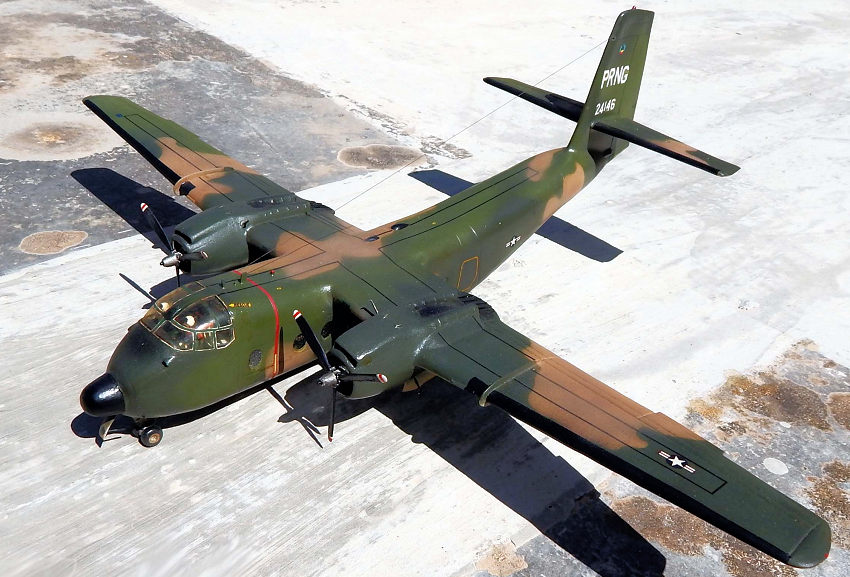
Formaplane 1/72 DHC-4 "Caribou"
| KIT #: | |
| PRICE: | |
| DECALS: | |
| REVIEWER: | Carmel J. Attard |
| NOTES: |
Vacuform with injected plastic and metal parts |

| HISTORY |
The de Havilland Canada DHC-4 Caribou (designated by the United States military as the CV-2 and later C-7 Caribou) is a Canadian-designed and produced specialized cargo aircraft with short takeoff and landing (STOL) capability. The Caribou was first flown in 1958 and although mainly retired from military operations, is still in use in small numbers as a rugged "bush" aircraft.
The de Havilland Canada company's third STOL design was a big step up in
size compared to its earlier DHC Beaver and DHC Otter, and was the first DHC
design powered by two engines. The Caribou, however, was similar in concept in
that it was designed as a rugged STOL utility aircraft. The C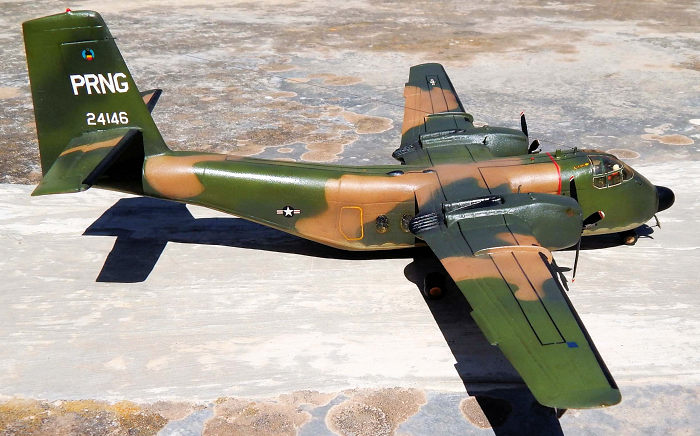 aribou
was primarily a military tactical transport that in commercial service found
itself a small niche in cargo hauling. The United States Army ordered 173 in
1959 and took delivery in 1961 under the designation AC-1, which was changed to
CV-2 Caribou in 1962 and later designated C-7.
aribou
was primarily a military tactical transport that in commercial service found
itself a small niche in cargo hauling. The United States Army ordered 173 in
1959 and took delivery in 1961 under the designation AC-1, which was changed to
CV-2 Caribou in 1962 and later designated C-7.
The majority of Caribou production was destined for military operators, but the type's ruggedness and excellent STOL capabilities requiring runway lengths of only 1200 feet (365 metres) also appealed to some commercial users. U.S. certification was awarded on 23 December 1960. Ansett-MAL, which operated a single example in the New Guinea highlands, and AMOCO Ecuador were early customers, as was Air America, (a CIA front in South East Asia during the Vietnam War era for covert operations). Other civil Caribou aircraft entered commercial service after being retired from their military users.
Today only a handful are in civil use. The U.S. Army purchased 159 of the aircraft and they served their purpose well as a tactical transport during the Vietnam War, where larger cargo aircraft such as the Fairchild C-123 Provider and the Lockheed C-130 Hercules could not land on the shorter landing strips. The aircraft could carry 32 troops or two Jeeps or similar light vehicles. The rear loading ramp could also be used for parachute dropping.
 The
invasion of Grenada in late 1983 can be seen as a small part of the rivalry
between the U.S. and Cuba during the President Ronald Reagan years. A bloody
coup in Grenada, along with a perceived threat to American students on the
island provided the U.S. with an excellent excuse to eliminate a Marxist regime
allied to Fidel Castro's Cuba. Among the aircraft that took part in the invasion
was spotted a C-7 Caribou belonging to the Puerto Rico Air National Guard and
was evidently lying on the tarmac at the main airfield in Granada among Cuban
registered An-24 transport and Mi-6 helicopters. President Reagan and his
administration were concerned that the Marxist government of Prime Minister
Maurice Bishop was allowing Cuba to gain undue influence in Grenada,
specifically by constructing a military-grade airport with Cuban military
engineers.
The
invasion of Grenada in late 1983 can be seen as a small part of the rivalry
between the U.S. and Cuba during the President Ronald Reagan years. A bloody
coup in Grenada, along with a perceived threat to American students on the
island provided the U.S. with an excellent excuse to eliminate a Marxist regime
allied to Fidel Castro's Cuba. Among the aircraft that took part in the invasion
was spotted a C-7 Caribou belonging to the Puerto Rico Air National Guard and
was evidently lying on the tarmac at the main airfield in Granada among Cuban
registered An-24 transport and Mi-6 helicopters. President Reagan and his
administration were concerned that the Marxist government of Prime Minister
Maurice Bishop was allowing Cuba to gain undue influence in Grenada,
specifically by constructing a military-grade airport with Cuban military
engineers.
The invasion sent a message to Cuba and Nicaragua that they could only go so far in exporting revolution in Central America and the Caribbean without provoking an American military response. This was the first time since before World War Two that an avowed Communist/Marxist government had been replaced with a pro-Western one.
| THE KIT |
The kit comes sealed in a polythene bag containing white sheets of vac form styrene that contains major items like fuselage halves, main planes and tail lanes, radial engines, wheel well doors. Several under-wing actuators of different sizes and the three undercarriage legs are all white metal. while the wheels are vac form parts. Clear Perspex for the canopy. Different interior bulkheads of different section sizes for the fuselage interior are also supplied.
| CONSTRUCTION |
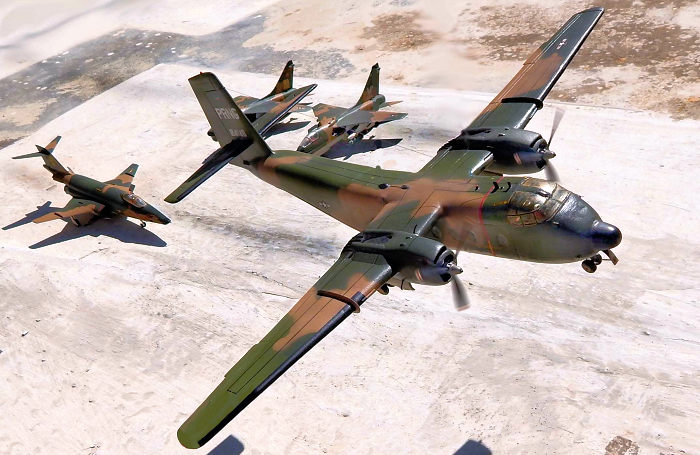 All parts
are cut away from the vacuum formed backing sheet and sand away the thickness of
plastic backing. All trailing edge surfaces are sanded down to as fine a section
as possible and the wing leading edges rounded off. Nacelles are cut and tabs
added to edges to help align engine halves together, Radial engine metal parts
are shaped to correct diameter and fitted inside the nacelles.
All parts
are cut away from the vacuum formed backing sheet and sand away the thickness of
plastic backing. All trailing edge surfaces are sanded down to as fine a section
as possible and the wing leading edges rounded off. Nacelles are cut and tabs
added to edges to help align engine halves together, Radial engine metal parts
are shaped to correct diameter and fitted inside the nacelles.
With reference to scale plans provided, the fuselage windows are first marked on sides and each one drilled open and oval shaped using a round file. A rectangular slot is cut at mid section where the wings come to join the fuselage. A bar is inserted inside the main wings and this will correspond to the wing on the other side at a later stage.
Cockpit canopy compartment is now built up adding
seating arrangement, instrument panel and central coaming, control wheels and
foot pedals. Three crew figures were also added. Interior compartment and cargo
section were then painted and crew figures added to their respective seating
arrangement. Nose wheel well was boxed using plastic card cut to shape and
interior detail added using reference material. Ahead of the well was another
compartment that housed small amount of lead weight to serve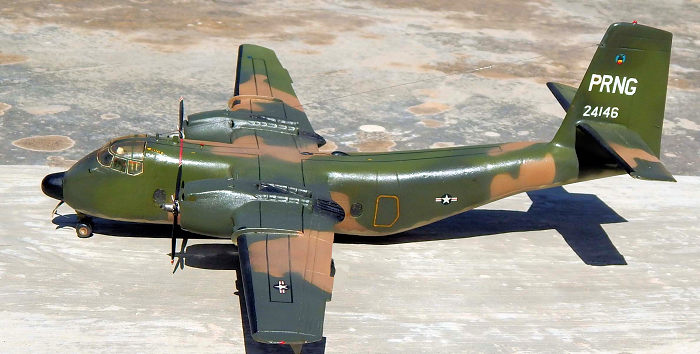 ,
as balance and the kit will rest on the nose wheel. Nose radome differed
slightly from that shown on drawing and this had to be replaced by another
radome that was shaped out of wood.
,
as balance and the kit will rest on the nose wheel. Nose radome differed
slightly from that shown on drawing and this had to be replaced by another
radome that was shaped out of wood.
Main fuselage had the bulkheads added inside and a cargo floor shaped from plastic card was fixed to one half of fuselage and the fuselage could then be closed. Wings complete with main spar added. Wings also had cross brackets to reinforce them, as the styrene was soft and of thin section that needed strengthening. The wings were then added to fuselage, glued and allowed to set. Tail planes were added in same fashion. . At this stage filler was added at joints and wing roots, once dry the excess filler was then sanded smooth. Metal undercarriage leg parts were then cleaned and secured inside the three Wheel well bays. Other details, flaps actuators, well doors were all added along with aerials and wireless.
| COLORS & MARKINGS |
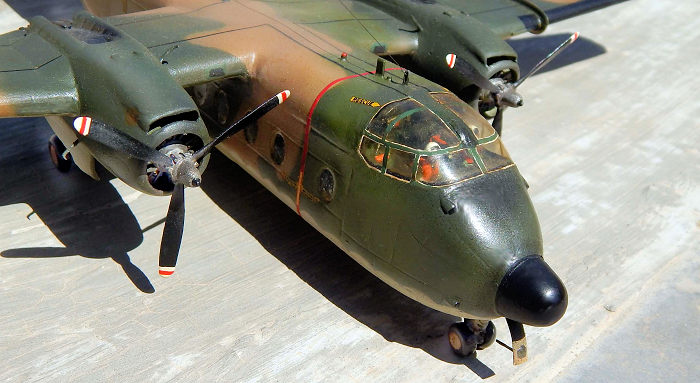 The model
was painted in Viet Nam style of camouflage colors making reference to standard
camouflage pattern obtained from other source. Cockpit canopy framing was hand
painted with a ‘0’ hand brush. Decals from spares selected to represent a
Caribou belonging to Puerto Rico Air National Guard squadron, which happened to
participate in the Invasion of Granada back in 1983. The model was finally given
a semi matt sheen using Model Master lacquer.
The model
was painted in Viet Nam style of camouflage colors making reference to standard
camouflage pattern obtained from other source. Cockpit canopy framing was hand
painted with a ‘0’ hand brush. Decals from spares selected to represent a
Caribou belonging to Puerto Rico Air National Guard squadron, which happened to
participate in the Invasion of Granada back in 1983. The model was finally given
a semi matt sheen using Model Master lacquer.
| CONCLUSIONS |
Not an easy kit build I have to admit particularly so because the styrene was soft with thin section all along and in fact each part was reinforced with interior plastic card strips more than that described above. The fuselage windows were covered with Kristal Kleer. The kit is accurate and is recommended to those keen on building transport types that served in combat zones.
| REFERENCES |
Wikipedia encyclopaedia.
If you would like your product reviewed fairly and fairly quickly, please contact the editor or see other details in the Note to Contributors.
Back to the Main Page Back to the Review Index Page Back to the Previews Index Page